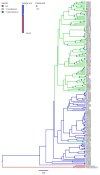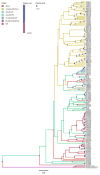Phylogenetic and geographic patterns of bartonella host shifts among bat species
- PMID: 27473781
- PMCID: PMC5025394
- DOI: 10.1016/j.meegid.2016.07.033
Phylogenetic and geographic patterns of bartonella host shifts among bat species
Abstract
The influence of factors contributing to parasite diversity in individual hosts and communities are increasingly studied, but there has been less focus on the dominant processes leading to parasite diversification. Using bartonella infections in bats as a model system, we explored the influence of three processes that can contribute to bartonella diversification and lineage formation: (1) spatial correlation in the invasion and transmission of bartonella among bats (phylogeography); (2) divergent adaptation of bartonellae to bat hosts and arthropod vectors; and (3) evolutionary codivergence between bats and bartonellae. Using a combination of global fit techniques and ancestral state reconstruction, we found that codivergence appears to be the dominant process leading to diversification of bartonella in bats, with lineages of bartonellae corresponding to separate bat suborders, superfamilies, and families. Furthermore, we estimated the rates at which bartonellae shift bat hosts across taxonomic scales (suborders, superfamilies, and families) and found that transition rates decrease with increasing taxonomic distance, providing support for a mechanism that can contribute to the observed evolutionary congruence between bats and their associated bartonellae. While bartonella diversification is associated with host sympatry, the influence of this factor is minor compared to the influence of codivergence and there is a clear indication that some bartonella lineages span multiple regions, particularly between Africa and Southeast Asia. Divergent adaptation of bartonellae to bat hosts and arthropod vectors is apparent and can dilute the overall pattern of codivergence, however its importance in the formation of Bartonella lineages in bats is small relative to codivergence. We argue that exploring all three of these processes yields a more complete understanding of bat-bartonella relationships and the evolution of the genus Bartonella, generally. Application of these methods to other infectious bacteria and viruses could uncover common processes that lead to parasite diversification and the formation of host-parasite relationships.
Keywords: Bartonella; Bats; Cophylogeny; Host-parasite relationships; Parasite diversification; Phylogeography.
Published by Elsevier B.V.
Figures




References
-
- Almeida FC, Giannini NP, Simmons NB. The evolutionary history of the African fruit bats (Chiroptera: Pteropodidae) Acta Chiropterologica. 2016;18:73–90. doi: 10.3161/15081109ACC2016.18.1.003. - DOI
Publication types
MeSH terms
Grants and funding
LinkOut - more resources
Full Text Sources
Other Literature Sources

